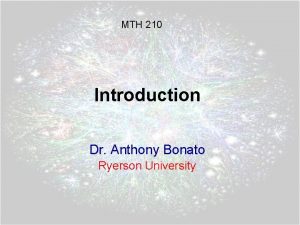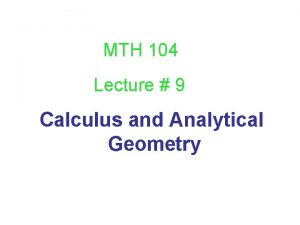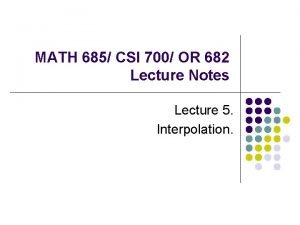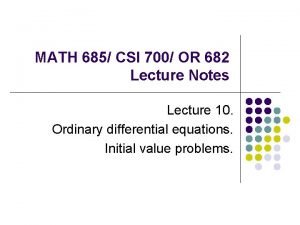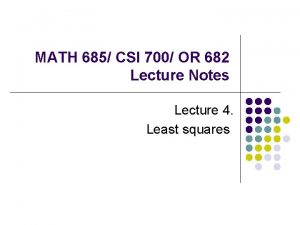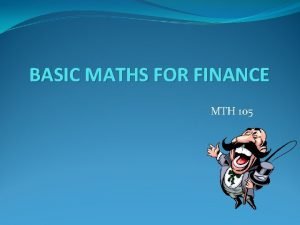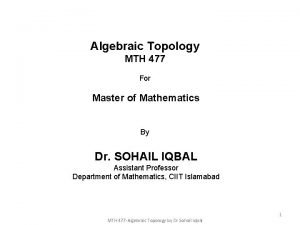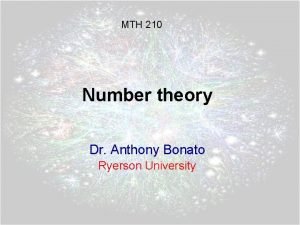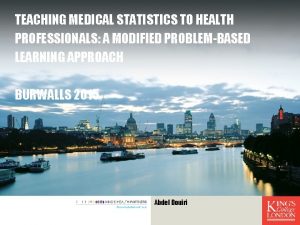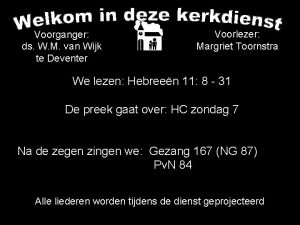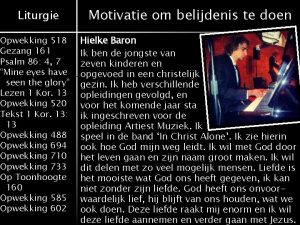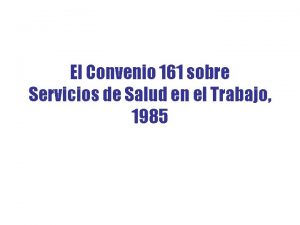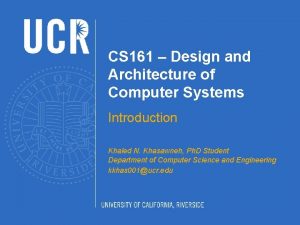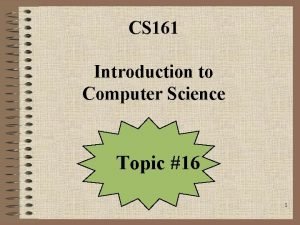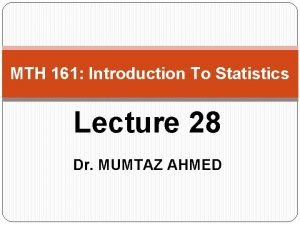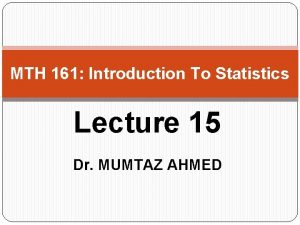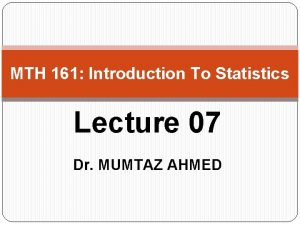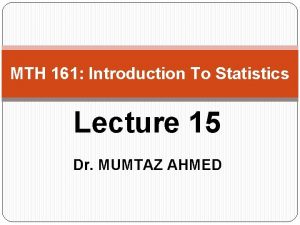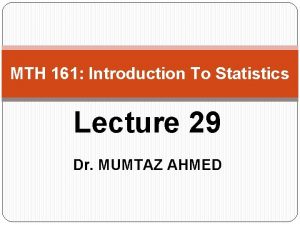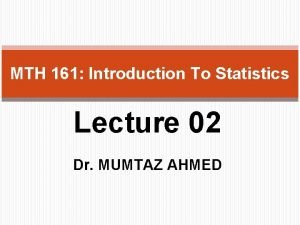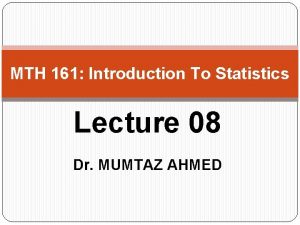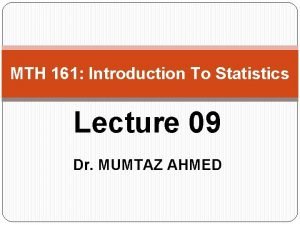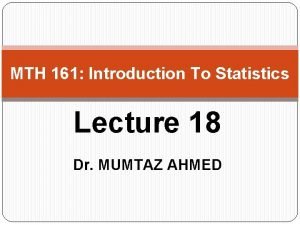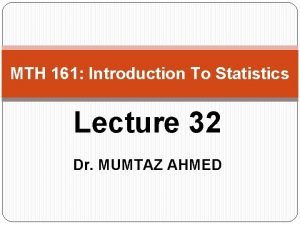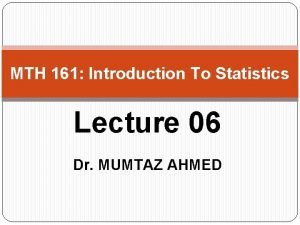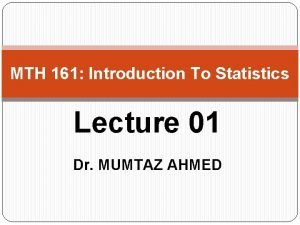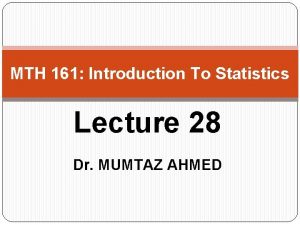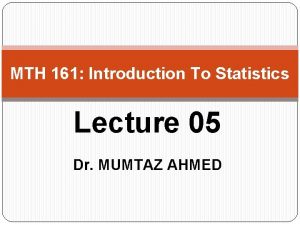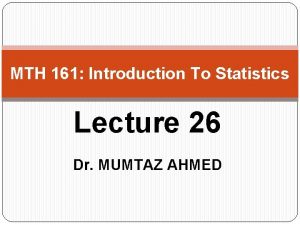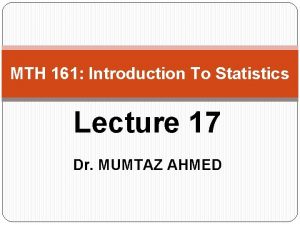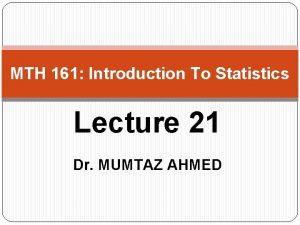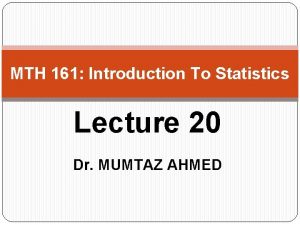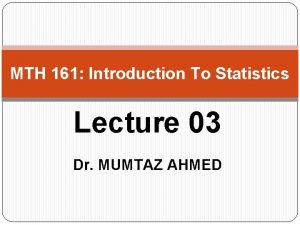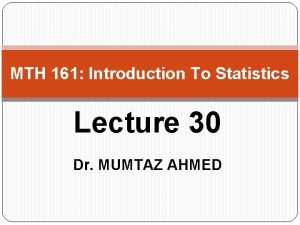MTH 161 Introduction To Statistics Lecture 19 Dr





















- Slides: 21

MTH 161: Introduction To Statistics Lecture 19 Dr. MUMTAZ AHMED

Review of Previous Lecture In last lecture we discussed: � Definition of Probability and its properties � Some basic questions related to probability � Laws of probability � More examples of probability 2

Objectives of Current Lecture In the current lecture: � Some More Examples of Probability � Conditional Probability � Independent and Dependent Events � Related Examples 3

Probability: Card Example � 4

Probability: Examples � 5

Probability: Examples Example: A pair of dice are thrown, what is the probability of getting a total of either 5 or 11? Solution: Here n(S)=36 Let A=a total of 5 occurs ={(1, 4), (2, 3), (3, 2), (4, 1)} n(A)=4, P(A)=4/36 Let B= a total of 11 occurs B={(5, 6), (6, 5)}, n(B)=2 P(B)=2/36 Note that A & B are mutually exclusive events, So P(AUB)=P(A)+P(B)=4/36+2/36=6/36=1/6 6

Probability: Examples Example: Three horses A, B and C are in a race; A is twice as likely to win as B and B is also twice as likely to win as C. What is the probability that either A or B wins? Solution: Let P(C)=p then P(B)=2 P(C)=2 p and P(A)=2 P(B)=2(2 p)=4 p Since A, B and C are mutually exclusive and collectively exhaustive events, So P(A)+P(B)+P(C)=1 p+2 p+4 p=1, 7 p=1, or So, P(C)=p=1/7, P(B)=2 p=2/7, p=1/7 P(A)=4 p=4/7 P(A or B wins)= P(AUB)=P(A)+P(B)=4/7+2/7=6/7 7

Conditional Probability The sample space for an experiment must often be changed when some additional information related to the outcome of the experiment is received. The effect of such additional information is to reduce the sample space by excluding some outcomes as being impossible which before receiving the information were believed possible. The probabilities associated with such a reduced sample space are called conditional probabilities. 8

Conditional Probability Example: Let us consider the die throwing experiment with sample space=S={1, 2, 3, 4, 5, 6} Suppose we wish to know the probability of the outcome that the die shows 6, say event A. So, P(A)=1/6=0. 166 If before seeing the outcome, we are told that the die shows an even number of dots, say event B. Then this additional information that the die shows an even number excludes the outcomes 1, 3 and 5 and thereby reduces the original sample space to only three numbers {2, 4, 6}. So P(6)=1/3=0. 333 We call 1/3 or 0. 333 as the conditional probability of event A because it is computed under the condition that the die has shown even number of dots. P(Die shows 6/die shows even numbers)=P(A/B)=1/3=0. 333 9

Conditional Probability: Examples � 10

Conditional Probability: Examples � 11

Conditional Probability: Examples � 12

Conditional Probability: Examples � 13

Multiplication Law � 14

Multiplication Law: Examples � 15

Multiplication Law: Examples � 16

Multiplication Law: Examples � 17

Multiplication Law: Examples � 18

Multiplication Law: Examples � 19

Review Let’s review the main concepts: � Conditional probability � Independent and Dependent Events � Related Examples 20

Next Lecture In next lecture, we will study: � Introduction to Random variables � Discrete Random Variables � Continuous Random Variables � Distribution Function 21
 Computer security 161 cryptocurrency lecture
Computer security 161 cryptocurrency lecture Introduction to statistics what is statistics
Introduction to statistics what is statistics Mth 210
Mth 210 Mth104
Mth104 Mth 685
Mth 685 Mth 685
Mth 685 Mth 685
Mth 685 Mth 105
Mth 105 Mth
Mth Mth 210
Mth 210 01:640:244 lecture notes - lecture 15: plat, idah, farad
01:640:244 lecture notes - lecture 15: plat, idah, farad Medical statistics lecture
Medical statistics lecture Gezang 161
Gezang 161 Ds van wijk deventer
Ds van wijk deventer Mini vidas parts
Mini vidas parts Port 161 snmp
Port 161 snmp Psalm 161
Psalm 161 Convenio 161 oit resumen
Convenio 161 oit resumen Ucr cs 161
Ucr cs 161 Jelena đorđevic 161
Jelena đorđevic 161 Inls 161
Inls 161 Computer science 161
Computer science 161


